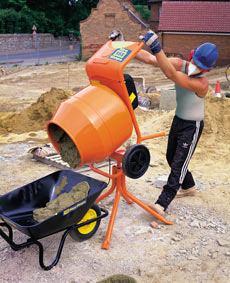Mixing concrete and mortar by hand is fairly easy to do and offers a good amount of control over the consistency of the mix. However, if you have a large amount of concrete or mortar to mix, it is often worth hiring a small cement mixer to make things easier. Cement mixers, both electric and petrol-driven mixers, are available to hire from most good tool hire shops and should not cost more than about £15 per day of hire. It is worth shopping around to find the best deal, but http://www.hss.com/ is a good place to start.
Preparing to Mix
Planning, as ever with DIY, is the key. Set up your cement mixer as close to where you are working as possible. Be sensible here! You need room to work around the mixer and will need to be able to get a wheelbarrow easily to and from the mixer, so don’t sacrifice room to work for the sake of getting the mixer 5ft closer to your job.
Place a piece of board under the mixer (or under the drum at the very least) to catch any spills and to help stabilise the machine. If you are using an electric mixer, make sure that cables are protected and not going to trip you or someone else up.
[stextbox id=”info”]Cement Mixer Safety – Make sure you know how to use the mixer before you begin and ask at the hire shop if unsure. Keep the mixer level, using blocks of wood under the legs if needed. Never put your hands or your shovel inside the drum while it is rotating. Don’t lean over the rotating drum to inspect the mix.[/stextbox]
Loading the Mixer
 You should already know what type of mix you will be using for the DIY task at hand, but if not you can check out our guide to Concrete and Mortar Mixes. A common concrete mix is one part cement, two parts sand and three parts coarse aggregate. If using combined aggregate, this mix would be 1:4, one part cement to four parts combined aggregate.
You should already know what type of mix you will be using for the DIY task at hand, but if not you can check out our guide to Concrete and Mortar Mixes. A common concrete mix is one part cement, two parts sand and three parts coarse aggregate. If using combined aggregate, this mix would be 1:4, one part cement to four parts combined aggregate.
Load half the mix into the drum and give it a dry mix by running the mixer for a minute or two without adding any water. Now gradually add water until the mix is looking pretty good. Add the remaining half of the mix and continue to add water until your concrete or mortar is at the required consistency. let the mixer run for a few more minutes to make sure that everything is combined properly. Stop the drum and test your mix to see if it is as required. Position your wheelbarrow under the drum and tip the mix in. Running the machine will help to get all of the mix out and into the barrow.
Cleaning the Mixer
It is a good idea to clean the drum out after each mix by running it with some water inside. At the end of the day, use water and a couple of handfuls of course aggregate to scour the remaining cement, etc, from the drum. This is particularly important if your cement mixer is hired. Returning a mixer with dry concrete or mortar in the drum could mean an additional charge from the hire shop.







